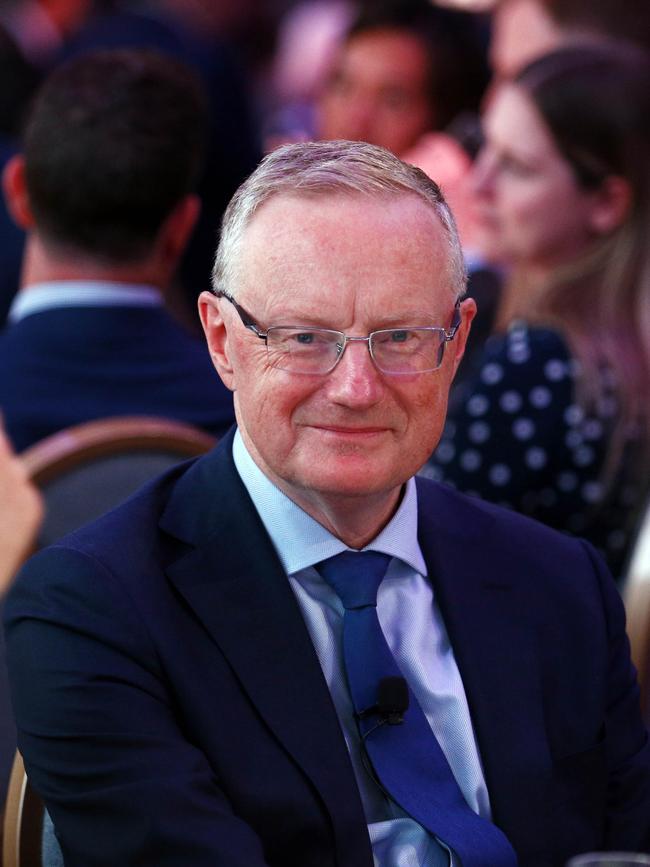RBA’s Philip Lowe cools interest rates guidance, but economists wary
Interest rate expectations continued to cool after a ‘less hawkish’ speech from RBA governor Philip Lowe – although economists aren’t rushing to conclude rates have peaked.
Interest rate expectations continued to cool after a “less hawkish” speech from RBA governor Philip Lowe – although economists weren’t rushing to conclude that interest rates have peaked.
After last week’s meeting, the RBA governor said: “Some further tightening of monetary policy may be required” to ensure that inflation returns to target in a reasonable time frame.
But the latest guidance was somewhat less definitive.
“It remains to be determined whether monetary policy has more work to do,” Dr Lowe said.
“It is possible that some further tightening will be required to return inflation to target.
“Whether or not this is required will depend on how the economy and inflation evolve.”
Dr Lowe said the board decided that, “having already increased rates substantially, it was appropriate to hold interest rates steady this month and re-examine the situation next month”.
Wednesday’s speech to the Economics Society was Dr Lowe’s last scheduled public appearance before Treasurer Jim Chalmers’s decision on the RBA leadership this month.
The RBA board was “very conscious that monetary policy operates with a lag and that the full effects of the tightening to date have not yet been felt,” Dr Lowe added.
He noted that it takes time for households and businesses to adjust their spending and investment plans, and noted that there are “still significant resets of low fixed-rate loans to come”.
“Given the lags, economic growth is expected to be subdued over the next couple of years and it will take time for inflation to return to target,” he said.

Australian government bond yields slipped a few basis points after Dr Lowe’s speech.
Cash rate futures implied a peak cash rate of 4.5 per cent, down from 4.56 per cent on Tuesday and a recent peak of 4.75 per cent. The Aussie dollar slipped from $US67.33c to $US66.81c.
It comes after Australian 10-year bond yields hit a decade high of 4.31 per cent this week.
In Q&A, Dr Lowe said he had “a completely open mind” on interest rates, and the issue of whether the RBA needs to do more “remains to be determined”.
Asked about whether he was more confident that the risks to inflation were less now compared to a couple of months ago, he said he was “confident that higher rates are working”.
Dr Lowe also stuck to his long-held view that the RBA can take longer for inflation to return to target than other central banks to preserve labour market gains since our wages growth is relatively slow.
“This will be the Governor’s legacy – generationally low unemployment, multi-decade lows in underemployment, record participation and employment/population,” said RBC Australia chief economist Su-Lin Ong.
“This is at the core of the RBA’s slower tightening cycle, its current stop/start hiking and possible elongated cycle with lower terminal versus its dollar bloc cousins.
“We would argue that the global experience, our labour market dynamics and some lag mean that it is far too early to suggest the risks to inflation are more balanced, but this shift in the RBA’s assessment suggests a slightly higher hurdle to hike much further.”
Dr Lowe also noted some important “cross-currents” on inflation.
Ongoing pricing pressures included a high level of capacity utilisation; strong growth in unit labour costs; a big pick-up in rents; and higher prices for electricity. But contributing to the easing of inflation were an easing of the Covid supply chain disruptions; a decline in commodity prices in global markets; and slow growth in aggregate demand, particularly in household consumption.
“The slow growth in demand is expected to lead to some rise in unemployment and a moderation in growth in unit labour costs,” he added. “It is also expected to reduce cost pressures on firms and to lead to greater discounting than has been the case over recent times.”
NAB head of market economics, Tapas Strickland, said the RBA may see emerging signs of economic growth slowing “reasonably significantly”, and recent US inflation trends were encouraging. But upside risks to inflation were likely to prompt another two rate hikes.
“NAB’s view remains that incoming inflation data in coming months will pressure the RBA’s confidence in returning inflation to target by the mid-2025 time frame, forcing the board to take out a little more insurance, even as growth slows,” he said.
Amid the numerous changes to the RBA’s monetary policy processes and communication that Dr Lowe said will be made from 2024 – including six-weekly board meetings – the governor did not discuss the RBA review’s recommendation the board target the midpoint of the 2-3 per cent bracket.
“If adopted, this would likely require even tighter policy,” NAB’s Mr Strickland said.






To join the conversation, please log in. Don't have an account? Register
Join the conversation, you are commenting as Logout